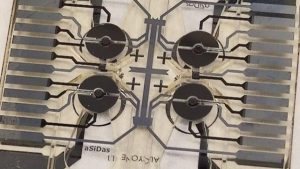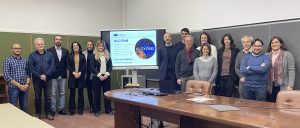This groundbreaking research reveals how a new microgravity bioreactor could revolutionise experiments in space.
As humanity sets its sights on long-duration space missions to destinations like Mars and the Moon, a fundamental challenge emerges: understanding how biological systems respond to the harsh, alien environment of space. Our ability to establish sustainable lunar bases, successfully send astronauts to Mars, and even explore beyond depends critically on deciphering these biological shifts.
Currently, much of our space biology research relies on indirect or limited methods. There’s a pressing need for in-situ, real-time investigation to truly understand how life adapts, or struggles, off-world.
Our novel microgravity bioreactor offers a groundbreaking solution to these limitations. This device has been developed within the project ALCYONE, funded by the EU under the Horizon Europe program, and coordinated by the School of Aerospace Engineering of Sapienza University of Rome. Its core purpose is to enable complex biological experiments directly within the space environment, providing a controlled and sustained platform for research that was previously impossible. This innovative technology is incredibly important because it opens doors to significant advancements in a deeper understanding of human health in microgravity and high radiation conditions.

Space environment challenges
Microgravity – or more accurately, weightlessness – is the condition in which the effects of gravity are greatly reduced. This occurs when an object is in continuous free fall, such as during orbital flight or in open space. This profound absence of the constant gravitational pull we experience on Earth has far-reaching and often detrimental effects on biological systems. At the cellular level, microgravity influences fundamental processes such as gene expression, cell differentiation, and intercellular communication.
On the other hand, the effect of radiation on living cells in space is a paramount concern for human space exploration, especially as missions extend beyond Earth’s protective magnetosphere towards the Moon and Mars. Unlike terrestrial radiation, space radiation consists of highly energetic particles, primarily Galactic Cosmic Rays (GCRs) and Solar Particle Events (SPEs), which can penetrate spacecraft shielding and living tissues. These types of ionising radiation cause damage at the molecular level, most critically to DNA. This damage can lead to harmful biological effects, including:
Significant likelihood of an increase in various cancers upon long-term exposure
Damages to brain cells, leading to cognitive deficits, memory problems, and changes in mood or behaviour.
Accelerated aging effects, including cataracts, cardiovascular disease, and organ damage
Impairment of the immune system, making astronauts more susceptible to infections in the confined spacecraft environment.
Understanding these effects is fundamental for developing advanced shielding materials and potentially developing biological resilience strategies. Without a comprehensive grasp of radiation’s impact, the long-term viability of human presence in deep space remains a critical challenge.
ALCYONE technology: A space-ready bioreactor
Traditional ground-based simulations often introduce undesirable stress on biological samples and can only approximate a real space condition, not even a complete one. Furthermore, it is currently not possible to recreate on the ground the complex radiation environment encountered in space. It is precisely this ‘gap’ between terrestrial simulations and real space conditions that our microgravity bioreactor aims to bridge. By being designed for in-situ operation directly in space, our bioreactor provides a sustained and genuine microgravity and radiation environment for biological samples, free from the misleading factors of shear stress, partial gravity effects, and the need for constant reorientation inherent in ground-based systems.
On the contrary, direct access to the space environment allows for unprecedented opportunities to observe, manipulate and understand biological processes as they truly unfold off-world, offering a more accurate and reliable platform for cutting-edge space biology research.
Lab-on-a-chip innovation: Designing for microgravity
The architectural design activity of the core ALCYONE lab-on-chip device, as well as its fabrication, has been the main focus of the project coordinator’s team at Sapienza University of Rome, along with the team of the University of Twente. Our microgravity bioreactor stands apart through a suite of novel design and engineering innovations, meticulously crafted to excel in the demanding space environment.
A primary focus has been compactness and miniaturisation, ensuring a minimal footprint that enables seamless integration into the tight confines of spacecraft. This small size factor maximises valuable payload volume, making space-based biological research more accessible and cost-effective than ever before. Central to its functionality is an advanced microfluidic system, which forms the core of our bioreactor. This system precisely controls minimal volumes of fluids, drastically reducing reagent consumption and enabling multiple parallel experiments within a small area.
This microfluidic approach is complemented by an advanced automated operation system designed and implemented by Kayser Italia s.r.l. (Livorno, Italy), an industrial partner of the project. This includes sophisticated micro pumps and precision valves for automated media exchange, enabling precisely controlled nutrient delivery and efficient waste removal, guaranteeing optimal conditions for long-duration experiments.
One of the most important technologies that pushed the innovation of the ALCYONE project is the integration of thin-film sensors and actuators onto the same substrates that constitute the micro-incubator, making it a ‘real’ lab-on-chip device that does not require external laboratory instrumentation for handling the local environmental conditions as well as for monitoring the status of the incubated biological samples. Integrated environmental controls utilise a miniature thin-film metallic heater for each incubation chamber and dedicated ultra-sensitive hydrogenated amorphous silicon (a-Si:H) temperature sensors to maintain precise temperature levels.
The selection of materials is the outcome of a critical design consideration within the definition process of the chip architecture, particularly given the high radiation environment of space. Biocompatible materials are specifically employed in direct contact with biological samples within the microfluidic channels, ensuring no interference with cellular processes. These material choices not only withstand the rigours of launch and space exposure but also guarantee the purity and viability of the biological cultures, even under prolonged radiation exposure.
Furthermore, the bioreactor boasts impressive modularity and versatility. Its adaptable microfluidic chamber design allows for the accommodation of various cell types, including mammalian cells, yeast and microbial cultures, along with different experimental setups, enabling a broad spectrum of research. While operating in-situ in true microgravity, the internal fluid dynamics within the bioreactor are optimised through precisely engineered microchannel geometries and passive flow control techniques. This ensures uniform nutrient distribution and waste removal around the samples, preventing unintended shear forces or nutrient gradients that could mimic partial gravity effects, thereby guaranteeing consistent and authentic microgravity exposure to the cells.
Bioluminescent cells and smart sensors
Another core aspect of the ALCYONE project is the use of bioluminescence as an analytical approach for monitoring the status of cell cultures. To this aim, the teams of the Department of Chemistry (Giacomo Ciamician) of the University of Bologna and the Department of Biology of the University of Rome (Tor Vergata) genetically modified prokaryotic and eukaryotic cells to equip them with luciferase-based reporter systems to track specific stress responses.
Crucially, bioluminescence-based sensing is integrated directly into the microfluidic chip for continuous, real-time monitoring of cell metabolic activity. The same a-Si:H thin-film technology, available at Sapienza University, is used to fabricate the photosensors that are used to monitor the analytical signal that correlates with the stress conditions of the biological sample. This non-invasive optical method provides vital insights into cellular responses to microgravity and radiation without disrupting the experiment.
Radiation monitoring: A CubeSat-sized breakthrough
As a final key element of the ALCYONE project, an innovative radiation monitoring system based on CERN’s TimePix device, coupled to a novel high-sensitivity sensor technology, has been developed by the team of the Karlsruhe Institute of Technology to study the radiation environment to correlate with biological results. The team did a great job designing such an advanced object within the constraints and limitations of a CubeSat payload.
From design to validation
Before any physical build, the design underwent extensive ground-based validation through simulation testing. Computational Fluid Dynamics (CFD) analysis was critical in optimising the internal fluid flow dynamics within the microfluidic channels, ensuring uniform nutrient delivery and waste removal within the microgravity environment, and minimising undesirable shear forces.
Simultaneously, structural analysis simulations rigorously tested the bioreactor’s resilience to the extreme forces of launch and the vacuum of space, verifying its structural integrity under worst-case scenarios and considering the high radiation environment.
Other experiments focused on demonstrating the bioreactor’s fundamental functionality, particularly the precision of the micro pumps and valves, the accuracy of the luminescence-based stress monitoring, and overall viability under controlled conditions. Liquid tightness of the microfluidic channels, power consumption, and thermal stability maintained by the heaters were also continuously monitored and optimised.
Bringing our innovative microgravity bioreactor from concept to a tangible, space-ready device involved a rigorous fabrication process and comprehensive validation.
Key manufacturing steps included advanced microfabrication techniques for the microfluidic channels and chambers, including the thin-film electronic devices. This involved processes like specialised bonding techniques to create the multi-layered microfluidic chips.
Looking ahead, we are exploring opportunities for integration into dedicated CubeSat missions, which would provide cost-effective platforms for initial autonomous space-flight testing, further refining its operational parameters, and directly assessing the performance of the microfluidic system and bioluminescence monitoring under real space radiation before larger-scale human spaceflight applications. These next steps will conclusively demonstrate the bioreactor’s performance and reliability in the authentic space environment.
To this end, a key factor will be represented by the heritage of the School of Aerospace Engineering of Sapienza University of Rome, with a score of more than ten successful satellite missions in the past twenty years, entirely developed within and educational scheme involving young researchers and students from the design to the in-orbit operation of micro- and nano-satellite missions.

Toward the first mission
Our on-orbit bioreactor promises to be a catalyst for significant scientific breakthroughs, fundamentally transforming our understanding of life beyond Earth. By providing a sustained and real microgravity environment for in-situ research, specifically utilising its advanced microfluidic system and integrated bioluminescence monitoring, it will dramatically accelerate our knowledge of how space affects human physiology. This capability directly supports the development of life support systems crucial for long-duration missions to Mars and beyond, where resupply is impractical. The bioreactor’s ability to conduct complex biological experiments in space also opens doors for novel discovery. Its continuous cell health monitoring via bioluminescence is particularly powerful for assessing the effectiveness of potential countermeasures for issues like radiation exposure, allowing for rapid, high-fidelity screening of protective compounds.
Looking ahead, our next steps involve further integrating even more advanced, multi-modal sensors for real-time, high-resolution monitoring of cellular processes and environmental parameters, including direct radiation dose monitoring at the cellular level. We envision incorporating AI-driven analysis to autonomously interpret complex biological data, including stress responses under radiation, and optimise experimental protocols. Further enhancements will focus on increased automation and miniaturisation, aiming for fully autonomous modules capable of performing extended research campaigns with minimal human intervention, truly paving the way for a new era of precision space biotechnology and enabling sustained human presence across the solar system.
Unlocking the future of space biotechnology
Our novel microgravity bioreactor stands as a crucial advancement in space biology, offering an unprecedented platform for conducting complex biological experiments directly in the authentic space environment. By overcoming the inherent limitations of terrestrial simulators, it provides a vital tool for understanding life’s responses to microgravity in ways previously impossible. This innovative technology is not just about scientific curiosity; it’s about paving the way for a sustainable human presence beyond Earth.
By revealing the secrets of how biological systems thrive or adapt in space, our bioreactor will be instrumental in developing robust life support systems, essential countermeasures for astronaut health, and even new pharmaceuticals. It truly unlocks new frontiers in scientific discovery and underscores the exciting possibilities, indeed, the developed technology opens up for the future of space exploration and biotechnology.

The project ALCYONE has received funding by the European Union’s Horizon Europe programme under grant agreement No. 101082679
Please note, this article will also appear in the 23rd edition of our quarterly publication.
Source link

